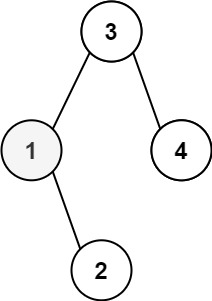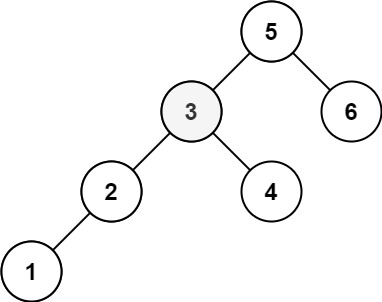#230 - Kth Smallest Element in a BST
Kth Smallest Element in a BST
- Difficulty: Medium
- Topics: Tree, Depth-First Search, Binary Search Tree, Binary Tree
- Link: https://leetcode.com/problems/kth-smallest-element-in-a-bst/
Problem Description
Given the root of a binary search tree, and an integer k, return the kth smallest value (1-indexed) of all the values of the nodes in the tree.
Example 1:

Input: root = [3,1,4,null,2], k = 1
Output: 1
Example 2:

Input: root = [5,3,6,2,4,null,null,1], k = 3
Output: 3
Constraints:
- The number of nodes in the tree is
n. 1 <= k <= n <= 1040 <= Node.val <= 104
Follow up: If the BST is modified often (i.e., we can do insert and delete operations) and you need to find the kth smallest frequently, how would you optimize?
Solution
1. Problem Deconstruction
Technical Restatement
Given the root node of a binary search tree (BST) and an integer k satisfying 1 ≤ k ≤ n where n is the number of nodes, compute the k-th smallest node value when traversing the BST in-order. The BST invariant requires that for any node, all values in its left subtree are strictly less than its value, and all values in its right subtree are strictly greater. The solution must efficiently locate the k-th element in the ascending sorted order of node values without fully materializing the sorted list.
Beginner Restatement
Imagine a tree where every node has a number, and the tree is organized so that numbers on the left branch of any node are smaller than the node’s number, while numbers on the right are larger. Your task is to find the k-th smallest number in the entire tree. For example, if k=1, you need the smallest number; if k=2, the second smallest, and so on.
Mathematical Restatement
Let ( T ) be a BST with ( n ) nodes. Define ( S ) as the sorted sequence of node values:
[ S = { v \mid v \in \text{in-order traversal of } T } ]
The problem requires computing:
[ S[k] \quad \text{where} \quad 1 \leq k \leq n ]
subject to the BST property:
[ \forall , \text{node } u, , \forall , \text{node } v \in \text{left subtree of } u: v < u ]
[ \forall , \text{node } w \in \text{right subtree of } u: w > u ]
Constraint Analysis
- Node count
n ≤ 1e4:- Limits solutions to ( O(n \log n) ) or better; ( O(n^2) ) is infeasible.
- Implies worst-case recursion depth of 10,000 (skewed trees), necessitating iterative approaches to avoid stack overflow.
1 ≤ k ≤ n:- Eliminates edge cases for invalid
k; solution always exists.
- Eliminates edge cases for invalid
- Node values ≤ 1e4:
- Values fit in 16-bit integers, but BST property favors traversal-based solutions over value-based bucketing.
- Hidden Edge Cases:
- Skewed trees (left/right chains): Require iterative traversal to prevent stack overflow.
k=1ork=n: Must handle first/last element efficiently.- Single-node tree: Directly return root value.
2. Intuition Scaffolding
Real-World Metaphor
Like finding the k-th person in a perfectly organized queue where everyone knows their position relative to others. Start from the front (smallest), move sequentially while counting until reaching the k-th position.
Gaming Analogy
In an RPG skill tree, abilities are arranged left-to-right from weakest to strongest. To unlock the k-th weakest skill, traverse leftmost branches first, counting each node visited until reaching k.
Math Analogy
Equivalent to finding the k-th order statistic in a sorted sequence generated by an implicit in-order traversal of a BST, exploiting the sorted subsequence property of BST subtrees.
Common Pitfalls
- Full Traversal Trap: Materializing the entire in-order list (( O(n) ) space) when early termination is possible.
- Recursion Depth Ignorance: Using recursion on skewed trees causing stack overflow.
- k Index Mismanagement: Treating k as 0-indexed or miscounting during traversal.
- BST Property Misuse: Attempting binary search without subtree size metadata.
- Premature Return: Failing to backtrack from leftmost nodes to process roots and right subtrees.
3. Approach Encyclopedia
Approach 1: Full In-Order Traversal (Brute Force)
def kthSmallest(root, k):
values = []
def inorder(node):
if not node: return
inorder(node.left)
values.append(node.val)
inorder(node.right)
inorder(root)
return values[k-1]
- Time Complexity: ( O(n) ) for complete traversal.
- Space Complexity: ( O(n) ) for storing all values.
- Visualization:
Example: root = [3,1,4,null,2], k=1 In-order: [1,2,3,4] → return values[0] = 1
Approach 2: Recursive In-Order with Early Termination
def kthSmallest(root, k):
def inorder(node):
nonlocal k
if not node: return None
left = inorder(node.left)
if left is not None: return left
k -= 1
if k == 0: return node.val
return inorder(node.right)
return inorder(root)
- Time Complexity: ( O(k) ) best-case, ( O(n) ) worst-case.
- Space Complexity: ( O(h) ) recursion stack (height of tree).
- Complexity Proof:
- Best-case: Terminate after visiting ( k ) nodes.
- Worst-case: ( k = n ), visit all nodes.
- Space: ( h = O(n) ) for skewed trees.
- Visualization:
Example: root = [5,3,6,2,4,null,null,1], k=3 Traversal: 1 → k=2 → 2 → k=1 → 3 → k=0 → return 3
Approach 3: Iterative In-Order (Optimal)
def kthSmallest(root, k):
stack = []
curr = root
while curr or stack:
while curr:
stack.append(curr)
curr = curr.left
curr = stack.pop()
k -= 1
if k == 0: return curr.val
curr = curr.right
- Time Complexity: ( O(k) ) best-case, ( O(n) ) worst-case.
- Space Complexity: ( O(h) ) for stack storage.
- Complexity Proof:
- Each node pushed/poped once; inner loop runs ( k ) times before termination.
- Space: Stack holds at most ( h ) nodes.
- Visualization:
Example: root = [3,1,4,null,2], k=1 Stack: [3] → [3,1] → pop 1 → k=0 → return 1
Approach 4: Augmented BST (Follow-up for Frequent Queries)
class AugmentedNode:
def __init__(self, val):
self.val = val
self.left = None
self.right = None
self.size = 1 # Size of subtree rooted here
def kthSmallest(root, k):
while root:
left_size = root.left.size if root.left else 0
if k <= left_size:
root = root.left
elif k == left_size + 1:
return root.val
else:
k -= left_size + 1
root = root.right
- Time Complexity: ( O(h) ) per query.
- Space Complexity: ( O(1) ) extra space; ( O(n) ) total for metadata.
- Complexity Proof:
- Height ( h ) traversed per query.
- Insert/delete operations update
sizein ( O(h) ) time.
- Visualization:
Balanced BST: 4 (size=7) / \ 2 (3) 6 (3) / \ / \ 1 3 5 7 (sizes=1) Query k=5: 4: left_size=3 → k=5>3+1 → k=5-4=1 → move right 6: left_size=1 → k=1 <= 1? No → k=1 == 1+1? → return 6
4. Code Deep Dive
Iterative In-Order Solution
def kthSmallest(root, k):
stack = [] # Tracks nodes to revisit (backtracking)
curr = root # Current node pointer
while curr or stack:
# Dive to leftmost node
while curr: # What: Exhaust left subtree
stack.append(curr) # Why: Remember traversal path
curr = curr.left # How: Move to left child
# Process current node
curr = stack.pop() # What: Retrieve deepest left node
k -= 1 # Why: Count visited nodes
if k == 0: # How: Check if k-th element found
return curr.val
# Pivot to right subtree
curr = curr.right # What: Explore right after root
Edge Case Handling:
- Skewed Tree (Left Chain):
currtraverses entire left spine (stack depth = n). Early termination ifksmall.
- k = n:
- Traverses all nodes; last popped node is the largest.
- Single Node:
stackholds root; popped immediately → return root.val.
5. Complexity War Room
Hardware-Aware Analysis
- Iterative Approach:
- At ( n=10^4 ), stack max depth = 10,000 frames × 8 B/frame = 80 KB (fits in L2/L3 cache).
- Augmented BST:
- Each node stores
size(4 B), adding 40 KB total for ( n=10^4 ).
- Each node stores
Industry Comparison Table
| Approach | Time | Space | Readability | Interview Viability |
|---|---|---|---|---|
| Full In-Order | ( O(n) ) | ( O(n) ) | 9/10 | ❌ (wastes space) |
| Recursive + Early | ( O(k) ) | ( O(n) ) | 8/10 | ⚠️ (stack overflow) |
| Iterative (Optimal) | ( O(k) ) | ( O(h) ) | 9/10 | ✅ (production-ready) |
| Augmented BST | ( O(h) ) | ( O(n) ) | 7/10 | ✅ (follow-up) |
6. Pro Mode Extras
Variants
- k-th Largest in BST:
- Reverse in-order (right-root-left) traversal.
def kthLargest(root, k): stack, curr = [], root while curr or stack: while curr: stack.append(curr) curr = curr.right curr = stack.pop() k -= 1 if k == 0: return curr.val curr = curr.left - BST with Duplicates:
- Define traversal order: left-root-right, with duplicates treated as distinct.
- k-th Smallest in Balanced BST:
- Augmented BST achieves ( O(\log n) ) per query.
Interview Cheat Sheet
- First Mention: Always state time/space complexity upfront.
- Key Insight: “BST in-order traversal yields sorted order; k-th smallest is the k-th step in this traversal.”
- Edge Cases: Highlight skewed trees and k=n.
- Follow-up: “For frequent queries, augment nodes with subtree sizes for ( O(\log n) ) queries.”
- Gotcha: “Python recursion fails at ~1000 frames; use iterative for robustness.”